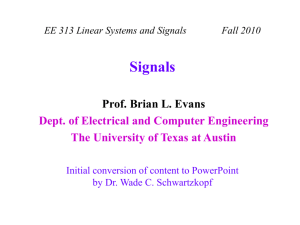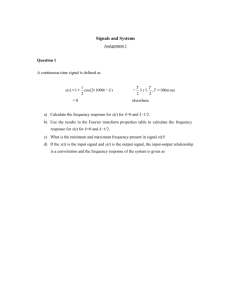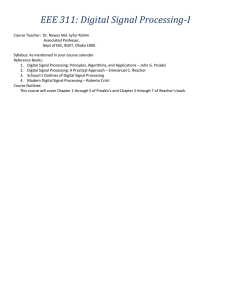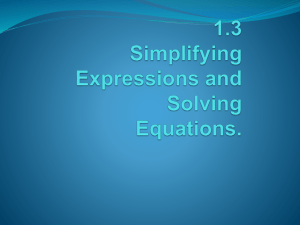Chapter 3. Time-Domain Analysis of DT Systems
advertisement
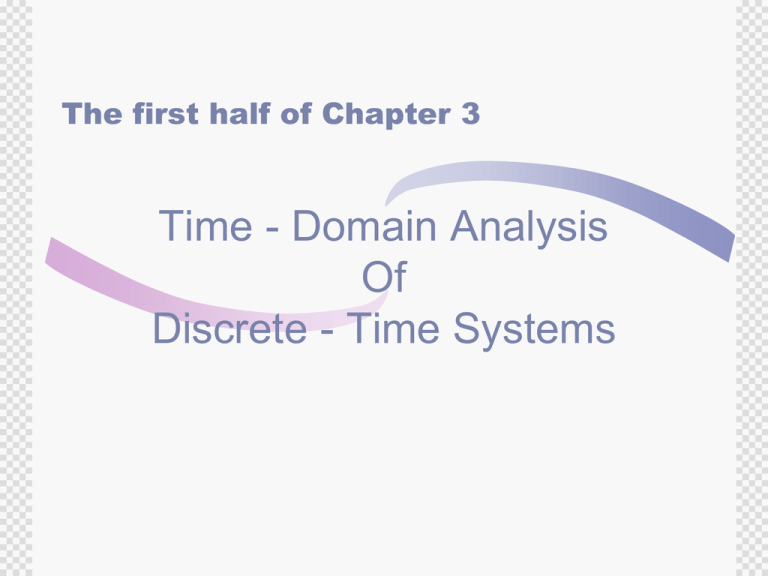
The first half of Chapter 3 Time - Domain Analysis Of Discrete - Time Systems 3.1. Introduction 3.1-0 Discrete signals and systems Discrete-Time Signal A Sequence of numbers inherently Discrete-Time sampling Continuous-Time signals, ex) x[n], y[n] Discrete-Time System Inputs and outputs are Discrete-Time signals. A Discrete-Time(DT) signal is a sequence of numbers DT system processes a sequence of numbers x[n] to yield another sequence y[n] . Signal and System II 2 3.1. Introduction Discrete-Time Signal by sampling CT signal x(t ) e t x(nT ) e nT e 0.1n x[n] C D ,D C T = 0.1 : Sampling interval n : Discrete variable taking on integer values. conversion to process CT signal by DT system. Signal and System II 3 3.1. Introduction 3.1-1 Size of DT Signal Energy Signal Ex x[n] 2 (3.1) n Signal amp. 0 as n Ex Power Signal 1 N 2 Px lim x [ n ] N 2 N 1 N (3.2) for periodic signals, one period time averaging. • A DT signal can either be an energy signal or power signal • Some signals are neither energy nor power signal. Signal and System II 4 3.1. Introduction Example 3.1 (1) Signal and System II 5 3.1. Introduction Example 3.1 (2) Signal and System II 6 3.2. Useful Signal Operations Shifting xS [n] x[n 5] Left shift Right shift Advance Delay nnM nnM M 0 Figure 3.4 time shift Signal and System II 7 3.2. Useful Signal Operations Time Reversal xr [n] x[n] anchor point cf) , : n n n = 0 x[n] Figure 3.4 time reversal Signal and System II 8 3.2. Useful Signal Operations Example 3.2 x[k n] x[n k ] x[(n k )] 1. 2. advance( k ) reverse nn k n n x[n] x[n k ] x[n k ] reverse delay( k ) n n n n k x[n] x[n] x[(n k )] Signal and System II 9 3.2. Useful Signal Operations Sampling Rate Alteration : Decimation and Interpolation decimation ( down sampling ) xd [n] x[Mn] , M must be integer values Signal and System II (3.3) 10 3.2. Useful Signal Operations interpolation ( expanding ) x[n / L] xe [n] 0 n 0, L, 2L,...., otherwise L must be integer value more than 2. Signal and System II (3.4) 11 3.3. Some Useful DT Signal Models 3.3-1 DT Impulse Function 1 [n] 0 n0 n0 (3.5) Signal and System II 12 3.3. Some Useful DT Signal Models 3.3-2 DT Unit Stop Function 1 u[n] 0 n0 n0 (3.6) Signal and System II 13 3.3. Some Useful DT Signal Models Example 3.3 (1) x[n] x1[n] x2[n] x3[n] n(u[n] u[n 5]) 4(u[n 5] u[n 11]) 2 [n 8] for all n Signal and System II 14 3.3. Some Useful DT Signal Models Example 3.3 (2) Signal and System II 15 3.3. Some Useful DT Signal Models 3.3-3 DT Exponential γn e t CT Exponential et t ex) e n ( r e or ln( ) ) e0.3t (0.7408)t n Nature of ( e 4t e1.386t or ln( ) ) n e n e( a jb) n (e a e jb ) n n e a e jb e a1 e a Signal and System II 16 3.3. Some Useful DT Signal Models plane plane a 0 exp. dec. LHP Inside the unit circle a 0 exp. inc. a 0 osc. RHP Outside the unit circle Imaginary axis Unit circle 1 n n Signal and System II 17 3.3. Some Useful DT Signal Models Signal and System II 18 3.3. Some Useful DT Signal Models 3.3-4 DT Sinusoid cos(Ωn+Θ) DT Sinusoid : c cos(n ) c cos(2Fn ) c : Amplitude : phase in radians n : angle in radians : radians per sample F : DT freq. (radians/2π) per sample or cycles for sample F 1 , N0 N 0 : period (samples/cycle) Signal and System II 19 3.3. Some Useful DT Signal Models About Figure 3.10 cos( n ) 12 4 12 F 1 (cycles/sample) 2 24 cos(n ) cos(n ), same freq. Sampled CT Sinusoid Yields a DT Sinusoid CT sinusoid cos wt sampling T Seconds x[n] cos wnT cos n, Signal and System II wT 20 3.3. Some Useful DT Signal Models 3.3-5 DT Complex Exponential ejΩn e jn cosn j sin n e jn cosn j sin n freq : e jn re j r 1, n a point on a unit circle at an angle of n Signal and System II 21 3.4. Examples of DT Systems 3.4-0 Example 3.4 (Savings Account) input x[n] : a deposit in a bank regularly at an interval T. output y[n] : balance interest r : per dollar per period T. balance y[n] = previous balance y[n-1] + interest on y[n-1] + deposit x[n] y[n] y[n 1] ry[n 1] x[n] (1 r ) y[n 1] x[n] or y[n] ay[n 1] x[n], a 1 r (3.9a) delay operator form (causal) withdrawal : negative deposit, x[n] loan payment problem : y[0] M or x[0] M y[n 1] ay[n] x[n 1] : n n 1 (3.9b) advance operator form (noncausal) Signal and System II 22 3.4. Examples of DT Systems Block diagram (a)addition, (b)scalar multiplication, (c)delay, (d)pickoff node Signal and System II 23 3.4. Examples of DT Systems Example 3.5 (Scalar Estimate) n : n th semester x[n] : students enrolled in a course requiring a certain textbook y[n] : new copies of the book sold in the n th semester. ¼ of students resell the text at the end of the semester. book life is three semesters. 1 1 y[n 1] y[n 2] x[n] 4 16 1 1 y[n 2] y[n 1] y[n] x[n 2] 4 16 y[n] (3.10a) (3.10b) Block diagram 1 1 y[n] y[n 1] y[n 2] x[n] 4 16 (3.10c) Signal and System II 24 3.4. Examples of DT Systems Example 3.6 (1) (Digital Differentiator) Design a DT system to differentiate CT signals. Signal bandwidth is below 20kHz ( audio system ) x[n] x(nT), y[n] y(nT) dx y (t ) , t nT dt dx 1 y (nT ) lim x(nT ) x((n 1)T ) : backward difference dt t nT T 0 T Signal and System II 25 3.4. Examples of DT Systems Example 3.6 (2) 1 1 x[n] x[n 1] x[n] x[n 1] T 0 T T y[n] lim T : Sufficiently small 1 1 T 25s 2 highest freq. 40,000 Signal and System II 26 3.4. Examples of DT Systems Example 3.6 (3) < in case of x(t ) t > x[n] x(t ) t nT t t nT nT t 0 y[n] 1 nT (n 1)T 1 n 1 T Forward difference y[n] 1 x[n 1] x[n] T Signal and System II 27 3.4. Examples of DT Systems Example 3.7 ( Digital Integrator ) Design a digital integrator as in example 3.6 t y (t ) x( )d , t nT y (nT ) lim x(kT )T T 0 y[n] lim T T 0 T k x[k ], T 0 k n x[k ] : accumulator k y[n] y[n 1] Tx[n] block diagram : similar to that of Figure 3.12 ( a 1 ) Signal and System II 28 3.4. Examples of DT Systems Recursive & Non-recursive Forms of Difference Equation y[n] T x[k ] (3.14a), y[n] y[n 1] Tx[n] (3.14b) k Kinship of Difference Equations to Differential Equations Differential eq. can be approximated by a difference eq. of the same order. The approximation can be made as close to the exact answer as possible by choosing sufficiently small value for T . Order of a Difference Equation The highest – order difference of the output or input signal, whichever is higher. Analog, Digital, CT & DT Systems DT, CT the nature of horizontal axis Analog, Digital the nature of vertical axis. -DT System : Digital Filter -CT System : Analog Filter -C/D, D/C : A/D, D/A Signal and System II 29 3.4. Examples of DT Systems Advantage of DSP 1. Less sensitive to change in the component parameter values. 2. Do not require any factory adjustment , easily duplicated in volume, single chip (VLSI) 3. Flexible by changing the program 4. A greater variety of filters 5. Easy and inexperience storage without deterioration 6. Extremely low error rates, high fidelity and privacy in coding 7. Serve a number of inputs simultaneously by time-sharing, easier and efficient to multiplex several D. signals on the same channel 8. Reproduction with extreme reliability Disadvantage of DSP 1. Increased system complexity (A/D, D/A interface) 2. Limited range of freq. available in practice (about tens of MHz) 3. Power consumption Signal and System II 30 3.4. Examples of DT Systems 3.4-1 Classification of DT Systems Linearity & Time Invariance k1 x1 k2 x2 k1 y1 k2 y2 Systems whose parameters do not change with time (n) If the input is delayed by K samples, the output is the same as before but delayed by K samples. Ex) y[n] e n x[n] for x1[n] and x2[n] x1[n N0 ] Causal & Noncausal Systems output at any instant n k depends only on the value of the input x[n] for n k Invertible & Noninvertible Systems S is invertible if an inverse system Si exists s.t. the cascade of S and Si results in an identity system Ex) unit delay unit advance ( noncausal ) Cf) y[n] x[Mn], y[n] cos x[n], y[n] x[n] Signal and System II 31 3.4. Examples of DT Systems Stable & Unstable Systems (1) The condition of BIBO ( Boundary Input Boundary Output ) and external stability y[n] h[n] x[n] h[m]x[n m] m y[n] m m h[m]x[n m] h[m] x[n m] If x[n] is bounded, then x[n m] K1 , and y[n] K1 h[m] m Clearly the output is bounded if the summation on the right-hand side is bounded; that is h[n] K n 2 Signal and System II 32 3.4. Examples of DT Systems Stable & Unstable Systems (2) Internal ( Asymptotic ) Stability For LTID systems, e j and n e j n n Since the magnitude of e jn is 1, it is not necessary to be considered. n Therefore in case of if 1, n 0 as n ( stable ) if 1, n as n ( unstable ) if 1, 1 for all n n Signal and System II ( unstable ) 33 3.4. Examples of DT Systems Memoryless Systems & Systems with Memory Memoryless : the response at any instant n depends at most on the input at the same instant n . Ex) y[n] sin x[n] With memory : depends on the past, present and future values of the input. Ex) y[n] y[n 1] x[n] Signal and System II 34 3.5. DT System Equations Difference Equations y[n N ] a1 y[n N 1] aN 1 y[n 1] aN y[n] bN M x[n M ] bN M 1 x[n M 1] bN 1 x[n 1] bN x[n] order : (3.16) max(N , M ) Causality Condition causality : M N if not, y[n N ] would depend on x[n M ] if M N , y[n N ] a1 y[n N 1] aN 1 y[n 1] aN y[n] b0 x[n N ] b1 x[n N 1] bN 1 x[n 1] bN x[n] (3.17a) delay operator form y[n] a1 y[n 1] aN 1 y[n N 1] aN y[n N ] b0 x[n] b1 x[n 1] bN 1 x[n N 1] bN x[n N ] Signal and System II (3.17b) 35 3.5. DT System Equations 3.5-1 Recursive (Iterative) Solution of Difference Equations y[n] a1 y[n 1] a2 y[n 2] aN y[n N ] b0 x[n] b1 x[n 1] bN 1 x[n N 1] bN x[n N ] (3.17c) y[0] : • N initial conditions • input x[0] • x[n] 0 for causality Example 3.8 (1) Signal and System II 36 3.5. DT System Equations Example 3.8 (2) Signal and System II 37 3.5. DT System Equations Example 3.9 Closed – form solution Signal and System II 38 3.5. DT System Equations Operation Notation Differential eq. Difference eq. Operator D for differentiation Operator E for advancing a sequence. Ex[n] x[n 1], E 2 x[n] x[n 2] y[n 1] ay[n] x[n 1] Ey[n] ay[n] Ex[n] ( E a) y[n] Ex[n] y[n 2] 1 1 y[n 1] y[n] x[n 2] 4 16 1 2 (E 4 E 1 ) y[n] E 2 x[n] 16 (E N a1E N 1 aN 1E aN ) y[n] (b0 E N b1E N 1 bN 1E bN ) x[n] (3.24a) Q[ E ] y[n] P[ E ]x[n] (3.24b) Q[E] E N a1E N 1 aN 1E aN (3.24c) P[ E] b0 E N b1E N 1 bN 1E bN (3.24d) Signal and System II 39 3.5. DT System Equations Response of Linear DT Systems ( E N a1E N 1 aN 1E aN ) y[n] (b0 E N b1E N 1 bN 1E bN ) x[n] Q[ E ] y[n] P[ E ]x[n] (3.24a) (3.24b) LTID system General solution = ZIR (zero input response) + ZSR (zero state response) Signal and System II 40 END
